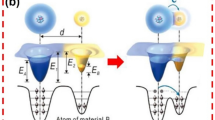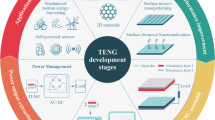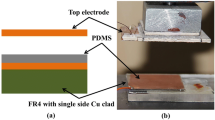Abstract
In recent years, triboelectric energy harvester devices have been considered as an interesting approach to generate electrical energy from the mechanical energy existing on the environment. In this work, a triboelectric energy harvester has been implemented through polyethylene terephthalate (PET) covered by ITO substrates for developing a contact-separation mode of operation device. The voltage signals were measured at open-circuit condition as well as with a set of load resistances. The corresponding peak-to-peak and rms current and power were calculated from registered signals. The main results show that the device behaves as a voltage source with a large series resistance with a linear dependence of the generated voltage with the applied force. The peak-to-peak voltage at open-circuit condition reached a value of about 39 V when a contact force of 1.22 N is applied, while the peak-to-peak voltage drop on the load resistance reached values about of 27 V. Besides, the maximum peak-to-peak power and power density transferred to a load resistance were 330 µW. and 60 µW/cm2, respectively. Finally, the rms power and power density of 740 nW and 135 nW/cm2, respectively, were achieved. The easy generator implementation with PET/ITO substrates makes feasible their integration with electronic circuits for flexible and large area electronic systems.






Similar content being viewed by others
Data availability
Data are available from the corresponding author on reasonable request.
References
A. Haroun, M. Tarek, M. Mosleh, F. Ismail, Recent Progress on triboelectric nanogenerators for vibration energy harvesting and vibration sensing. Nanomaterials 12, 2960 (2022). https://doi.org/10.3390/nano12172960
C. Xu, Y. Song, M. Han, H. Zhang, Portable and wearable self-powered systems based on emerging energy harvesting technology. Microsyst. Nanoeng. 7, 25 (2021). https://doi.org/10.1038/s41378-021-00248-z
X. Zhang, Overview of Triboelectric Nanogenerators, in Flexible and stretchable triboelectric nanogenerator devices: toward self-powered systems, First, ed. by M. Han, X. Zhang, H. Zhang (John Wiley, Weinheim, 2019), pp.1–18. https://doi.org/10.1002/9783527820153.ch1
C. Qiu, F. Wu, Q. Shi, C. Lee, M. Yuce, Sensors and control interface methods based on triboelectric nanogenerator in IoT applications. IEEE Access 7, 92745–92757 (2019). https://doi.org/10.1109/ACCESS.2019.2927394
I. Shabbir, N. Rubab, T.W. Kim, S.-W. Kim, Healthcare management applications based on triboelectric nanogenerators. APL Mater. 9, 060703 (2021). https://doi.org/10.1063/5.0052605
Z. Wang, G. Zhu, Y. Yang, S. Wang, S. Pan, Progress in nanogenerators for portable electronics. Mater. Today 15(12), 532–543 (2012). https://doi.org/10.1016/S1369-7021(13)70011-7
P. Huang, D.-L. Wen, Y. Qiu, M.-H. Yang, C. Tu, H.-S. Zhong, X.-S. Zhang, Textile-based triboelectric nanogenerators for wearable self-powered microsystems. Micromachines 12, 158 (2021). https://doi.org/10.3390/mi12020158
C. Xu, Y. Zi, A.W. Wang, H. Zou, Y. Dai, X. He, P. Wang, Y.-C. Wang, P. Feng, D. Li, Z.L. Wang, On the electron-transfer mechanism in the contact-electrification effect. Adv. Mater. 30, 1706790 (2018). https://doi.org/10.1002/adma.201706790
A. Simões, D. Carvalho, E. Morita, H. Moretti, H. Vendrameto, L. Fu, F. Torres, A. Souza, W. Bizzo, T. Mazon, A triboelectric nanogenerator for energy harvesting from transformers’ vibrations. Machines 10, 215 (2022). https://doi.org/10.3390/machines10030215
K. Shi, H. Zou, B. Sun, P. Jiang, J. He, X. Huang, Dielectric modulated cellulose paper/PDMS-based triboelectric nanogenerators for wireless transmission and electropolymerization applications. Adv. Funct. Mater. 30, 1904536 (2019). https://doi.org/10.1002/adfm.201904536
S. Pyo, D.-S. Kwon, H.-J. Ko, Y. Eun, J. Kim, Frequency up-conversion hybrid energy harvester combining piezoelectric and electromagnetic transduction mechanisms. Int. J. Precision Eng. Manuf.-Green Technol. 9, 241–251 (2022). https://doi.org/10.1007/s40684-021-00321-y
H.H. Singh, D. Kumar, N. Khare, A synchronous piezoelectric–triboelectric–electromagnetic hybrid generator for harvesting vibration energy. Sustain. Energy Fuels 5, 212–218 (2021). https://doi.org/10.1039/d0se01201g
X. He, Q. Wen, Y. Sun, Z. Wen, A low-frequency piezoelectric-electromagnetic-triboelectric hybrid broadband vibration energy harvester. Nano Energy 40, 300–307 (2017). https://doi.org/10.1016/j.nanoen.2017.08.024
C. Liu, N. Zhang, J. Li, L. Dong, T. Wang, Z. Wang, G. Wang, X. Zhou, J. Zhang, “Harvesting ultralow frequency (< 1 Hz) mechanical energy using triboelectric nanogenerator”, Nano Energy, vol. 65, pp. 104011, 2019. DOI: https://doi.org/10.1016/j.nanoen.2019.104011
G. Min, L. Manjakkal, D.M. Mulvihill, R.S. Dahiya, Triboelectric nanogenerator with enhanced performance via an optimized low permittivity substrate. IEEE Sens. J. 20(13), 6856–6862 (2020). https://doi.org/10.1109/JSEN.2019.2938605
J. Huang, W. Wu, R. Zhang, G. Lu, B. Chen, Z. Chen, C. Gui, Novel electrode material using electroless nickel plating for triboelectric nanogenerator: Study of the relationship between electrostatic-charge density and strain in dielectric material. Nano Energy 92, 106734 (2022). https://doi.org/10.1016/j.nanoen.2021.106734
M. Su, J. Brugger, B.J. Kim, Wearable triboelectric generator based on a hybrid mix of carbon nanotube and polymer layers. J. Phys. Conf. Ser. 1407, 012047 (2019). https://doi.org/10.1088/1742-6596/1407/1/012047
I. Hussain, S. A. Khan, A. Q. Rahimoon, A. Abro, F. Hussain, Shamsuddin, M. Ali, “Flexible Triboelectric Nanogenerator Based on Paper, PET and Aluminum”, In Proceedings of the IEEE International Conference on Computing, Mathematics and Engineering Technologies – iCoMET 2019, 30–31 January 2019. DOI: https://doi.org/10.1109/ICOMET.2019.8673395
M. U. Bukhari, K. Riaz, T. Tauqeer, M. Sajid, “Simple and low cost triboelectric nanogenerator (TENG) for resource limited environment”, In Proceedings of the IEEE International Conference on Robotics and Automation in Industry (ICRAI), Rawalpindi, 21–22 October 2019. DOI: https://doi.org/10.1109/ICRAI47710.2019.8967354
S. Ali, V. Palaniappan, X. Zhang, D. Maddipatla, B. J. Bazuin, M. Z. Atashbar, “Investigating the Performance of Triboelectric Nanogenerators (TENGs) Fabricated Using”, In Proceedings of the IEEE International Conference on Flexible and Printable Sensors and Systems (FLEPS), Vienna, 10–13 July 2022. DOI: https://doi.org/10.1109/FLEPS53764.2022.9781542
P. Supraja, R.R. Kumar, S. Mishra, D. Haranath, P.R. Sankar, K. Prakash, N. Jayarambabu, T.V. Rao, U.K. Kumara, A simple and low-cost triboelectric nanogenerator based on two dimensional ZnO nanosheets and its application in portable electronics. Sens. Act. A: Phys. 335, 113368 (2022). https://doi.org/10.1016/j.sna.2022.113368
Y.-W. Cai, X.-N. Zhang, G.-G. Wang, G.-Z. Li, D.-Q. Zhao, N. Sun, F. Li, H.-Y. Zhang, J.-C. Han, Y. Yang, A flexible ultra-sensitive triboelectric tactile sensor of wrinkled PDMS/MXene composite films for E-skin. Nano Energy 81, 105663 (2021). https://doi.org/10.1016/j.nanoen.2020.105663
D.-S. Kwon, S. Pyo, J. Kim, “Self-Powered Wind Sensor Based on Triboelectric Generator with Curved Flap Array for Multi-Directional Wind Speed Detection”, In Proceedings of the IEEE 33rd International Conference on Micro Electro Mechanical Systems (MEMS), Vancouver, 18–22 January 2020, DOI: https://doi.org/10.1109/MEMS46641.2020.9056275
Funding
This research received no external funding.
Author information
Authors and Affiliations
Contributions
Conceptualization: OR-B, SAH and AGM-L; methodology, OR-B, SAH and AGM-L; software, SAH.; validation, OR-B, JCT and AGM-L; formal analysis, JCT and AGM-L; investigation, OR-B, JCT and AGM-L; resources, AGM-L; writing—original draft preparation, OR-B, JCT; writing—review and editing, JC and AGM-L.
Corresponding author
Ethics declarations
Conflict of interest
The authors declare that they have no conflict of interest.
Additional information
Publisher's Note
Springer Nature remains neutral with regard to jurisdictional claims in published maps and institutional affiliations.
Rights and permissions
Springer Nature or its licensor (e.g. a society or other partner) holds exclusive rights to this article under a publishing agreement with the author(s) or other rightsholder(s); author self-archiving of the accepted manuscript version of this article is solely governed by the terms of such publishing agreement and applicable law.
About this article
Cite this article
Rodriguez-Bernal, O., Hernandez, S.A., Conde, J. et al. Implementation of triboelectric generators based on PET/ITO substrates. J Mater Sci: Mater Electron 34, 428 (2023). https://doi.org/10.1007/s10854-023-09870-1
Received:
Accepted:
Published:
DOI: https://doi.org/10.1007/s10854-023-09870-1




